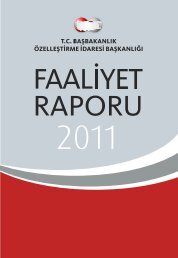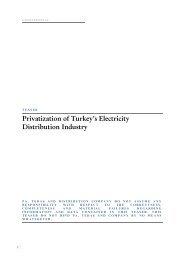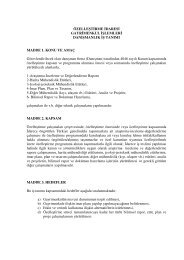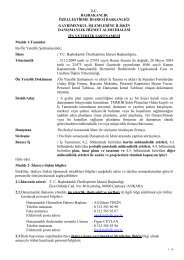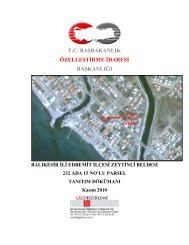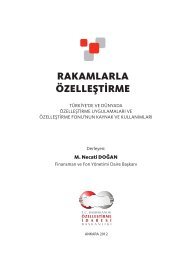Privatization of Turkey's Electricity Distribution Industry
Privatization of Turkey's Electricity Distribution Industry
Privatization of Turkey's Electricity Distribution Industry
Create successful ePaper yourself
Turn your PDF publications into a flip-book with our unique Google optimized e-Paper software.
CONFIDENTIAL<br />
TEASER<br />
<strong>Privatization</strong> <strong>of</strong> Turkey’s <strong>Electricity</strong><br />
<strong>Distribution</strong> <strong>Industry</strong><br />
PA, TEDAS AND D I STRI BUT I ON COMPANY DO NOT ASSUME ANY<br />
RESPONSI B I L I TY W I TH RESPECT TO THE CORRECTNESS,<br />
COMPLETENESS AND MATERI AL FA I LURES REGARDI NG<br />
I NFORMATI ON AND DATA CONTAI NED I N THI S TEAS ER. THI S<br />
TEASER DO NOT BI ND PA, TEDAS AND COMPANY BY NO MEANS<br />
WHATSOEVER.<br />
1
CONFIDENTIAL<br />
Table <strong>of</strong> Contents<br />
1. TEDAS PRIVATIZATION OVERVIEW 3<br />
2. KEY ASPECTS OF THE INTENDED PRIVATIZATION 5<br />
A. TSS MODEL 5<br />
B. ELECTRICITY TARIFFS 5<br />
C. POWER SUPPLY GUARANTEE 7<br />
D. INVESTMENT OBLIGATIONS 8<br />
3. INVESTMENT CONSIDERATIONS 10<br />
4. TURKISH ELECTRICITY MARKET OVERVIEW 11<br />
5. TENDER PROCESS 16<br />
A. TENDER PROCESS 16<br />
6. APPENDICES 17<br />
2
CONFIDENTIAL<br />
1. TEDAS PRIVATIZATION OVERVIEW<br />
Republic <strong>of</strong> Turkey Prime Ministry <strong>Privatization</strong> Administration (“PA”) is resuming the<br />
privatization <strong>of</strong> Turkey’s electricity distribution utility, Turkiye Elektrik Dagitim Anonim<br />
Sirketi (“TEDAS”). TEDAS is a Turkish State-owned joint-stock company engaged in the<br />
distribution and retail sale <strong>of</strong> electricity and provision <strong>of</strong> retail services to final customers.<br />
Turkey’s electricity distribution network has been divided into 21 distribution regions as<br />
announced in the Strategy Paper. TEDAS, which owns 20 <strong>of</strong> the 21 regions, has been<br />
included in the privatization programme, and a separate distribution company has been<br />
established in each <strong>of</strong> these 20 regions. Out <strong>of</strong> these 20 regions BASKENT and SEDAS<br />
have been privatized and handed over to private investors at the beginning <strong>of</strong> 2009. For<br />
MERAM and ARAS; privatization tenders have been held but the hand over process has not<br />
started yet. MENDERES and GÖKSU have been excluded from the privatization<br />
programme. With approximately 30.5 million customers, 134 billion kWh <strong>of</strong> electricity sales<br />
and 98% market share in electricity distribution across Turkey in 2008 (including privatized<br />
and excluded companies), TEDAS and its distribution companies together form one <strong>of</strong> the<br />
largest organizations in the country.<br />
The PA decided to proceed with the privatization <strong>of</strong> the electricity distribution sector,<br />
announcing on 10.04.2009 and 17.04.2009 the tender <strong>of</strong> three companies, each operating in<br />
one region, namely:<br />
• Region 16: Osmangazi <strong>Electricity</strong> <strong>Distribution</strong> Ltd. (“OSMANGAZI”);<br />
• Region 4: Çoruh <strong>Electricity</strong> <strong>Distribution</strong> Ltd. (“ÇORUH”).<br />
• Region 21: Yesilirmak <strong>Electricity</strong> <strong>Distribution</strong> Ltd. (“YESILIRMAK”)<br />
<strong>Privatization</strong> <strong>of</strong> distribution companies will be executed using a Transfer <strong>of</strong> Operating Rights<br />
(“TOR”) backed Share Sale model ("TSS model"). According to this model, the investor will<br />
be the sole owner <strong>of</strong> the shares <strong>of</strong> the distribution company and will be the unique licensee<br />
for the distribution <strong>of</strong> electricity in the designated region without retaining the ownership <strong>of</strong><br />
distribution network assets and other items that are essential for the operation <strong>of</strong> distribution<br />
assets. The ownership <strong>of</strong> these distribution assets will remain with TEDAS. The investor,<br />
through its shares in the distribution company, however, will be granted the right to operate<br />
the distribution assets by a Transfer <strong>of</strong> Operating Rights Agreement ("TOR Agreement")<br />
with TEDAS.<br />
Under the envisaged market structure, privatized electricity distribution companies will<br />
operate as regional monopolies with distribution licenses granted by Energy Markets<br />
Regulatory Authority (“EMRA”). As part <strong>of</strong> ongoing liberalization efforts in the energy<br />
sector, Turkey’s distribution network was divided into 21 distribution regions based on<br />
geographical proximity, managerial structure, energy demand and other technical/financial<br />
3
CONFIDENTIAL<br />
factors. After the inclusion <strong>of</strong> TEDAS in the privatization program, a separate distribution<br />
company was established by the PA in each one <strong>of</strong> the 20 distribution regions owned by<br />
TEDAS. The only distribution region excluded is the region operated by a partially private<br />
company is Kayseri (Region #18), whose operating rights were transferred to KCETAS in<br />
1990.The geographical coverage <strong>of</strong> the distribution regions are provided in the following<br />
map. 4 <strong>of</strong> the 20 regions in the program have been privatized by the PA in 2007 and 2008 by<br />
TSS model (BASKENT, SEDAS, ARAS and OSMANGAZI). Hand over process for 2<br />
regions (BASKENT and SEDAS) has been completed in 2009. In addition MENDERES<br />
EDAS, in accordance with law number 3096, has been handed over to the private sector on<br />
15.08.2008 and GÖKSU EDAS has been excluded from the privatization program in 2009<br />
so that it could be handed over as per law number 3096.<br />
13<br />
11<br />
12<br />
GEOGRAPHICAL COVERAGE OF DISTRIBUTION COMPANIES<br />
17 14 15<br />
16<br />
19 10<br />
9<br />
8<br />
21<br />
7<br />
18<br />
6<br />
20<br />
4<br />
5<br />
1<br />
Private<br />
company<br />
Tender completed<br />
transfer process<br />
ongoing<br />
3<br />
2<br />
1. Dicle elektrik Dagi tim A.S.<br />
2. Vangölü Elektrik Dagitim A.S.<br />
3. Aras Elektrik Dagitim A.S.<br />
4. Çoruh Elektrik Dagitim A.S.<br />
5. Firat Elektrik Dagitim A.S.<br />
6. Çamlibel Elektrik Dagi tim A.S.<br />
7. Toroslar Elektrik Dagitim A.S.<br />
8. Meram Elektrik Dagitim A.S.<br />
9. Baskent Elektrik Dagi tim A.S.<br />
10. Akdeniz Elektrik Dagitim A.S.<br />
11. Gediz Elektrik A.S.<br />
12. Uludag Elektrik Dagitim A.S.<br />
13. Trakya Elektrik Dagitim A.S.<br />
14. Istanbul Elektrik Dagitim A.S.<br />
15. Sakarya Elektrik Dagitim A.S.<br />
16. Osmangazi Elektrik Dagi tim A.S.<br />
17. Bogaziçi Elektrik Dagitim A.S.<br />
18. Kayseri Elektrik Dagi tim A.S.<br />
19. Menderes Elektrik Dagitim A.S.<br />
20. Göksu Elektrik Dagi tim A.S.<br />
21. Yesilirmak Elektrik Dagitim A.S.<br />
* State council has decided on 20.03.2009; a stay <strong>of</strong> execution <strong>of</strong> privatization <strong>of</strong> Aras Elektrik Dagitim A.S. following a law suit filed 2008/13541<br />
E.<br />
Source: PA<br />
4
CONFIDENTIAL<br />
2. KEY ASPECTS OF THE INTENDED PRIVATIZATION<br />
A.TSS MODEL<br />
The aim <strong>of</strong> the TSS model is to handover an operating distribution company to the investor.<br />
Establishment <strong>of</strong> the distribution company as a separate legal entity, signing <strong>of</strong> the TOR<br />
Agreement, provision <strong>of</strong> distribution and retail sales licenses and signing <strong>of</strong> the Energy Sales<br />
Agreements have been defined as the necessary steps for the TSS model implementation. All<br />
<strong>of</strong> these steps have already been completed prior to the privatization tender announcement.<br />
In the TSS model, asset ownership <strong>of</strong> new as well as existing distribution assets belong to<br />
TEDAS, while the investor attains the right to operate the distribution network together with<br />
the obligation to undertake all new necessary investments. In line with the privatization<br />
purposes and investor expectations:<br />
• The ownership <strong>of</strong> the existing assets and the new assets arising from investments to be<br />
carried out by the investor belong to TEDAS. The legal obligations relating to the asset<br />
base before the signing <strong>of</strong> the TOR Agreement (for example, expropriation costs),<br />
however, have been assumed by TEDAS.<br />
• The investor shall purchase the shares <strong>of</strong> a company which holds the operating rights <strong>of</strong><br />
distribution assets and all related assets (e.g., buildings, vehicles, machine park), and the<br />
electricity distribution and retail licenses in a given region.<br />
• All EMRA approved investments shall be realized by the investor and will be recovered<br />
through the tariffs. Except for cases <strong>of</strong> investor misconduct, the part <strong>of</strong> investments not<br />
yet recovered via the tariffs shall be paid by TEDAS to the investor upon the expiry or<br />
termination <strong>of</strong> the contract.<br />
B. ELECTRICITY TARIFFS<br />
According to the general principles as stated in the <strong>Electricity</strong> Market Strategy Paper 1 ,<br />
Turkish <strong>Electricity</strong> Market has gone through a process <strong>of</strong> vast restructuring in core activities<br />
ranging from generation to distribution. Accordingly, a new tariff structure has been<br />
developed inline with the new structural requirements in mind.<br />
The main purpose <strong>of</strong> the market liberalization is to achieve lower tariffs by increasing overall<br />
system efficiency. Accordingly, the tariffs are calculated as “cost-reflective” based on predetermined<br />
operating and loss/theft improvement targets.<br />
The first tariff implementation period (or transition period) has been set as five years from<br />
2006 to 2010 to serve as the transitory period to fully cost based tariff structure after 2010.<br />
This transitory period has been extended to 2012 by the law numbered 5784 and dated<br />
09.07.2008. The extension also applies to the tariff equalization mechanism. EMRA has<br />
1<br />
Decision <strong>of</strong> High Planning Council No. 2004/3 dated 17.03.2004<br />
5
CONFIDENTIAL<br />
already approved the end user tariffs and revenue requirements <strong>of</strong> each distribution company<br />
for the period between 2006 and 2010. Revenue requirements cover the projected expenses<br />
for providing distribution and retail services and provide an allowance for the target level <strong>of</strong><br />
technical and non-technical losses. After the expiration <strong>of</strong> EMRA approved tariffs, the new<br />
end-user tariffs will be determined by the distribution companies in accordance with the<br />
<strong>Electricity</strong> Market Tariffs Communiqué and the related regulations and will be subject to the<br />
Regulator’s approval.<br />
The first implementation period is designed to have a smooth and gradual transition from<br />
existing tariff structure to a lean and simple tariff structure. As <strong>of</strong> 2012, most customer<br />
groups will have cost based tariffs.<br />
According to the <strong>Electricity</strong> Market Law, the <strong>Electricity</strong> Market Tariffs Communiqué and<br />
other related regulation, the four tariff components 2 ; (a) retail sales, (b) distribution, (c) retail<br />
services and (d) transmission; are governed in an unbundled fashion. Retail sales tariff has a<br />
“price cap” which is set as the basket price <strong>of</strong> the energy purchased by the distribution<br />
company. <strong>Distribution</strong> and retail services have “revenue caps” which cover operating<br />
expenses and investment requirements related to distribution and retail services. Transmission<br />
tariff is a complete pass-through <strong>of</strong> transmission costs as charged by the national transmission<br />
company.<br />
Customers<br />
• Residential<br />
• Commercial<br />
• Industrial<br />
• Agricultural<br />
irrigation<br />
• Street<br />
lighenting<br />
<strong>Distribution</strong> system<br />
usage tariff<br />
DECOMPOSITION OF END-USER TARIFF<br />
Taxes and other<br />
deductions<br />
Transmission tariff<br />
Retail services tariff<br />
TEIAS<br />
<strong>Distribution</strong> OPEX<br />
component<br />
Investments<br />
amortization and<br />
cost <strong>of</strong> capital<br />
component<br />
TOR value<br />
component<br />
<strong>Distribution</strong><br />
Other charges*<br />
Company<br />
Lost/theft component<br />
Operating margin<br />
• Pass-through <strong>of</strong><br />
transmission costs<br />
Retail tariff<br />
Reference Price<br />
(Energy price)<br />
TETAS<br />
• Pass-through <strong>of</strong><br />
energy costs<br />
Total end-user<br />
electricity tariff<br />
* Duel-term tariffs: capacity charge, penalty for overload and reactive energy fee<br />
Source: TEDAS<br />
As stated in the Strategy Paper, the existing “national tariff” scheme will be maintained for<br />
the first tariff implementation period, rather than implementing “regional tariffs” in order to<br />
2<br />
Excluding taxes and other deductions component<br />
6
CONFIDENTIAL<br />
avoid sudden price fluctuations (currently, regional cost based tariffs vary significantly due to<br />
wide variation <strong>of</strong> loss/theft levels across the regions). Implementation <strong>of</strong> national tariffs,<br />
however, will result in revenue imbalances since the distribution company revenues will differ<br />
from its envisaged revenue cap. In order to remove such imbalances, the Regulator will<br />
employ a tariff equalization scheme to transfer revenues across the regions.<br />
TRANSITION PERIOD NATIONAL TARIFFS (1) (Krs/KWh)<br />
2006 2007 2008 2009 2010<br />
Industrial MV 11.63 11.52 11.40 11.30 11.19<br />
Industrial LV 11.63 11.63 11.63 11.63 11.63<br />
Commercial 14.75 14.50 14.15 13.87 13.62<br />
Residential 12.40 12.40 12.64 12.89 13.14<br />
Agricultural Irrigation 11.19 11.19 11.19 11.19 11.19<br />
Lightening 11.97 12.00 12.04 12.07 12.10<br />
(1) Applicable TEDAS wide average Tariffs<br />
Source: EMRA<br />
While the overall tariffs are pre-determined and approved for 2006-2010, the following<br />
revisions are allowed on the tariffs by the regulations:<br />
• Revenue Cap: The revenue caps are guaranteed regardless <strong>of</strong> the consumption levels in<br />
the region. Namely, if a distribution company underbills its revenue cap due to lower<br />
consumption, tariff adjustment is allowed for the subsequent year accordingly under the<br />
supervision <strong>of</strong> the Regulator. Moreover, the approved revenue caps for 2006-2010 will be<br />
inflation adjusted based on the changes in the <strong>Electricity</strong> Market Index (“EMI”)<br />
announced by the Regulator.<br />
• Retail price cap: The distribution company will reflect any increases in its energy sourcing<br />
costs to the price cap through a pass-through mechanism under the supervision <strong>of</strong> the<br />
Regulator.<br />
Other than the end-user tariffs, customers are also charged a distribution connection fee for<br />
the establishment <strong>of</strong> the initial connection to the distribution network, a collateral amount as<br />
a warranty for non-payment, and a disconnection/reconnection fee in case a disconnection<br />
or reconnection is required.<br />
C. POWER SUPPLY GUARANTEE<br />
It is stated in the Strategy Paper that during the transition period 2006-2010, distribution<br />
companies are to procure 85% <strong>of</strong> the regional energy demand consumed by non-eligible<br />
7
CONFIDENTIAL<br />
customers from TETAS and the portfolio generation companies carved out <strong>of</strong> EUAS.<br />
Accordingly, each distribution company inherited Energy Sales Agreements with TETAS and<br />
EUAS portfolio companies, which secure the majority <strong>of</strong> distribution companies’ energy<br />
needs for the transition period. In parallel with the extension <strong>of</strong> the transition period to 2012,<br />
Energy These Energy Sales Agreements have been established based on regulated prices for<br />
the transition period. After transition period, the distribution company will freely source its<br />
wholesale energy needs from alternative sources, e.g., bilateral contracts, spot market, vertical<br />
integration. The market balancing and settlement mechanism under the national transmission<br />
company, which has become operational recently in 2006, will remove daily market<br />
imbalances.<br />
D. INVESTMENT OBLIGATIONS<br />
One <strong>of</strong> the primary objectives <strong>of</strong> privatization is to finance required distribution system and<br />
network improvements and expansions through private sector investments, thereby<br />
removing the burden <strong>of</strong> such investments away from the State budget. Investments are <strong>of</strong><br />
great importance in ensuring continuity and quality <strong>of</strong> service in electricity distribution.<br />
The annual expansion, replacement and improvement investments that are required in each<br />
<strong>of</strong> the 20 distribution regions during the first tariff implementation period (2006 – 2010) have<br />
been determined during the preparation <strong>of</strong> the end-user tariffs. For TEDAS as a whole, the<br />
investment requirement for the transition period is a total <strong>of</strong> YTL 2,750 million in 2006 YTL<br />
terms, distributed equally to each year <strong>of</strong> the transition period. These investments have been<br />
embedded into the first implementation period tariffs approved by the Regulator; hence, they<br />
will be recouped by the distribution companies over time. Investment expenditures consist <strong>of</strong><br />
three components:<br />
• Expansion investments and expropriation cost: Investment expenditures for increasing<br />
the capacity <strong>of</strong> the existing network and the associated expropriation and right <strong>of</strong> way<br />
costs<br />
• Replacement investments: Investment expenditures for the replacement <strong>of</strong> the economic<br />
assets that have completed their economic lives in the existing network<br />
• Continuing investments: Investment expenditures for the completion <strong>of</strong> the already<br />
contracted projects, most <strong>of</strong> which are still continuing<br />
After 2010, distribution companies will prepare annual investment plans each year by making<br />
projections on consumption growth, analyzing network expansion requirements and other<br />
technical parameters. They will then present these investment plans to EMRA for approval.<br />
After receiving EMRA approval, distribution companies are obliged to implement the<br />
approved plans. Implementation <strong>of</strong> these investments (i.e. investment amount and form) will<br />
8
CONFIDENTIAL<br />
be monitored through investment control and quality measurement mechanisms set up by<br />
the Regulator in collaboration with the distribution companies.<br />
9
CONFIDENTIAL<br />
3. INVESTMENT CONSIDERA TIONS<br />
EMRA approved tariffs do incorporate an allowed level <strong>of</strong> regulated return on the electricity<br />
sales & distribution activities and investment requirements that will be undertaken by the<br />
distribution company. In addition to this allowed level <strong>of</strong> return, the distribution company can<br />
create substantial value by overperforming beyond the pre-approved loss/theft and operational<br />
efficiency targets. From the investor’s perspective and for the overall development <strong>of</strong> the<br />
electricity sector, the benefits and opportunities <strong>of</strong> the envisaged system can be summarized as<br />
follows:<br />
• The investor is allowed to retain excess value derived from outperforming the predetermined<br />
theft/loss targets approved by the Regulator. Accordingly, as a result <strong>of</strong> this<br />
policy, technical and non-technical losses, which have become an excessive financial<br />
burden in Turkey over the years, will be reduced to single digit figures.<br />
• The investor is allowed to retain the savings achieved through procuring energy at a<br />
lower cost than the regulated reference price. This policy will pave the way for<br />
construction <strong>of</strong> low-cost electricity production facilities.<br />
• The investor is allowed to retain excess value derived from outperforming the predetermined<br />
operational improvement targets approved by the Regulator. This will trigger<br />
efficiency improvement in electricity distribution. At each distribution company,<br />
substantial operational efficiency improvement is achievable through optimizing core<br />
business processes such as billing and collections, arranging and redesigning work flows,<br />
enabling effective coordination between divisions, improving information systems and<br />
infrastructure and optimizing personnel productivity.<br />
• Particularly after year 2010, distribution companies will be able to vertically integrate to<br />
produce electricity and sell excess production in an open market, thereby increasing their<br />
revenues. Vertical integration will be instrumental in the development <strong>of</strong> an open market<br />
in electricity.<br />
In a broader perspective, Turkey provides a strategic geographic position in the European<br />
energy markets with a stable and high growing electricity industry. Introduction <strong>of</strong> an<br />
effective regulation and a liberal market structure has further enhanced the industry growth<br />
prospects for the coming years. The Turkish electricity sector has been modeled on EU<br />
market structure and a transparent regulatory framework has been set by the independent<br />
authority, EMRA. In the following years further opportunities will arise for the privatized<br />
distribution companies from privatization/liberalization in the energy sector particularly in<br />
the generation area.<br />
10
CONFIDENTIAL<br />
4. TURKISH ELECTRICITY MARKET OVERVIEW<br />
The electricity industry is a large, high-growth sector in the Turkish economy. The industry<br />
constitutes an important part <strong>of</strong> the country’s GDP and is a USD 18.5 billion industry based<br />
on current end-user prices. The sector’s share in the Turkish economy has been growing<br />
rapidly, given the 10.6% per annum growth in electricity demand over the past two decades.<br />
This rate <strong>of</strong> demand growth has been higher than the growth rates seen in other major<br />
Turkish industries and outstrips growth in the Turkish economy overall.<br />
In 2007, the Turkish electricity sector recorded approximately 182 billion kWh <strong>of</strong> gross<br />
consumption (total consumption including loss/theft, internal consumption and exports) and<br />
155 billion kWh <strong>of</strong> net consumption (excluding loss/theft, internal consumption and<br />
exports). The industrials customer group represent approximately 50% <strong>of</strong> the total demand,<br />
while residential customers consume slightly less than a quarter <strong>of</strong> the total. Commercials<br />
customer group, excluding public institutions, is placed third in terms <strong>of</strong> consumption with a<br />
14% share.<br />
<strong>Distribution</strong> losses <strong>of</strong> the system, which amounted to 26.6 billion kWh in 2007, are high<br />
compared to international benchmarks. Accordingly, one <strong>of</strong> the primary objectives <strong>of</strong> the<br />
electricity sector reform has been defined as reducing the loss/theft ratio to OECD levels.<br />
<strong>Electricity</strong> generation, imports & exports, distribution losses and the net consumption <strong>of</strong><br />
main customer groups in 2007are summarized in the following chart.<br />
GENERATION & NET CONSUMPTION (1) , 2007<br />
PRODUCTION<br />
191.6 TWh<br />
INTERNAL<br />
CONSUMPTION<br />
8.2 TWh<br />
TOTAL<br />
192.5 TWh<br />
GRID LOSS<br />
4.5 TWh<br />
DISTRIBUTION LOSS<br />
22.1 TWh<br />
IMPORT<br />
0.9 TWh<br />
EXPORT<br />
2.4 TWh<br />
Industrial<br />
Residential<br />
74.5 TWh<br />
37.2 TWh<br />
Commercial<br />
21.7 TWh<br />
Other<br />
21.7 TWh<br />
CONSUMPTION<br />
155.1 TWh<br />
(1) Figures are in TWh; 1 TWh equals 1 billion kWh<br />
Source: TEDAS, TEIAS<br />
11
CONFIDENTIAL<br />
<strong>Electricity</strong> consumption growth has historically been less volatile than the overall economic<br />
growth in Turkey. Between 1980 and 2007, GDP growth displayed a wide variance with a<br />
standard deviation <strong>of</strong> 4.6% around an average growth rate <strong>of</strong> around 4%. Consumption<br />
growth in the electricity sector during the same time period displayed a lower standard<br />
deviation <strong>of</strong> 3.0%, around a higher average growth rate <strong>of</strong> approximately 8%. As can be seen<br />
in the next chart, electricity consumption growth was negative only in a single year over the<br />
past 27 years.<br />
ELECTRICITY CONSUMPTION VS. GDP GROWTH, 1980- 2007<br />
GDP growth<br />
Percent<br />
10<br />
5<br />
0<br />
• Average growth:<br />
%4,3<br />
• Standard deviation:<br />
%4,6<br />
-5<br />
-10<br />
1980 81<br />
82<br />
83<br />
84<br />
85<br />
86<br />
87<br />
88<br />
89<br />
90<br />
91<br />
92<br />
93<br />
94<br />
95<br />
96<br />
97<br />
98<br />
99 2000<br />
01<br />
02<br />
03<br />
04<br />
05<br />
06 2007<br />
Electrictyconsumption growth<br />
Percent<br />
15<br />
10<br />
5<br />
• Average growth:<br />
%7,8<br />
• Standard deviation:<br />
%3,0<br />
0<br />
-5<br />
1980 81 82 83 84 85 86 87 88 89 90 91 92 93 94 95 96 97 98 99 2000 01 02 03 04 05 06 2007<br />
Source: TEDAS, SIS<br />
Despite increasing demand, Turkey’s per capita gross consumption is still very low at 2,427<br />
kWh compared to the EU average <strong>of</strong> 6,602 kWh. According to the Ministry <strong>of</strong> Energy and<br />
Natural Resources (“MENR”) 2004-2020 projections that assume a continued cumulative<br />
annual growth rate <strong>of</strong> 7.7% in gross demand, per capita consumption is forecasted to reach<br />
5,700 kWh by 2020.<br />
<strong>Electricity</strong> consumption in Turkey has been growing at very high rates since the early 1980s.<br />
The next chart illustrates consumption growth for each customer group over the past two<br />
and a half decades. During the 1980s, average consumption growth was the same for all<br />
customer groups around 8%. After 1990s, however, consumption growth for residential and<br />
commercials customer groups outpaced that <strong>of</strong> industrials customer group. Nevertheless, the<br />
industrials segment still accounts for approximately 50% <strong>of</strong> electricity consumption in<br />
Turkey.<br />
12
CONFIDENTIAL<br />
ELECTRICITY CONSUMPTION BY CUSTOMER GROUP, 1980 – 2007 (TWh)<br />
Industrial/<br />
autoproducers<br />
Residentials<br />
Commercial<br />
Other*<br />
20,6<br />
6% 22% 9%<br />
64%<br />
29,7<br />
10%<br />
19%<br />
66%<br />
5%<br />
46,8<br />
13% 5%<br />
20%<br />
62%<br />
67,4<br />
16%<br />
6%<br />
22%<br />
56%<br />
CAGR<br />
7,8%<br />
99,3<br />
17%<br />
10%<br />
24%<br />
50%<br />
121,1<br />
15%<br />
13%<br />
23%<br />
49%<br />
143,1<br />
14%<br />
14%<br />
24%<br />
48%<br />
155,1<br />
14%<br />
14%<br />
24%<br />
48%<br />
Estimated<br />
industry revenues<br />
US$ billion<br />
1980<br />
1985<br />
1990<br />
1995<br />
0.9 1.7 3.5 5.1 7.7 11.5 15.0<br />
(1) <strong>Electricity</strong> used by public institutions, lightening, agricultural irrigation and non pr<strong>of</strong>it organizations such as schools and hospitals<br />
Sources: TEDAS, TEIAS<br />
The forces that fuel growth in the sector are continued economic and industrial development,<br />
population growth and improving income levels. According to projections prepared by the<br />
national transmission company TEIAS on supply growth, there is sufficient supply capacity<br />
at least until year 2009. Required investments for more capacity are expected to be covered<br />
primarily by private sector investments. Should this not take place, the State will take<br />
necessary measures to provide additional capacity, including imports and rehabilitation <strong>of</strong><br />
existing plants to provide supply assurance, as stated in the Strategy Paper.<br />
Turkish electricity sector was dominated by the State-owned vertically integrated company<br />
Turkiye Elektrik Kurunu (“TEK”) until the early 1990s. In 1993, in view <strong>of</strong> market<br />
liberalization and privatization, TEK was separated into TEAS (generation, transmission and<br />
wholesale) and TEDAS (distribution). Then, with the enactment <strong>of</strong> the <strong>Electricity</strong> Market<br />
Law in 2001, TEAS was further unbundled into EUAS (generation), TETAS (wholesale) and<br />
TEIAS (transmission), each being organized as a separate legal entity.<br />
2000<br />
2004<br />
2006<br />
2007<br />
18.5<br />
13
CONFIDENTIAL<br />
HISTORICAL DEVELOPMENT OF MARKET STRUCTURE<br />
Before 1993<br />
TEK<br />
(generation, transmission & distribution)<br />
Between<br />
1993 - 2003<br />
TEAS<br />
(generation & transmission)<br />
TEDAS<br />
(distribution)<br />
After 2003<br />
EUAS<br />
(generation)<br />
TEIAS<br />
(transmission)<br />
TETAS<br />
(wholesale)<br />
21 COMPANIES<br />
(distribution)<br />
Source: PA<br />
• EUAS was envisaged to take over the ownership and the operation <strong>of</strong> the State thermal<br />
power plants from TEAS and the hydroelectric power plants from the Devlet Su Isleri<br />
(“State Water Works”). EUAS was also empowered to build, lease and operate new<br />
generation facilities, if deemed necessary, in accordance with the EMRA approved<br />
generation capacity projections and taking into consideration the generation investments<br />
by the private sector.<br />
• TETAS was created to conduct wholesale operations and take over the existing energy<br />
sale and purchase agreements from TEAS and TEDAS. TETAS was also held<br />
responsible for managing the stranded costs associated with the Build Operate (“BO”),<br />
Build Operate Transfer (“BOT”) and TOR generation contracts.<br />
• TEIAS took over all transmission facilities owned by the State and was named<br />
responsible for transmission system operations and maintenance, developing<br />
transmission investment plans for new facilities and also for operating the market<br />
financial reconciliation center.<br />
Currently, State dominance is still very much prevalent across the electricity value chain. In<br />
2008, EUAS and its subsidiaries held 58% <strong>of</strong> the total installed generation capacity in Turkey<br />
and generated 49% <strong>of</strong> electricity produced countrywide. In transmission and wholesale,<br />
TEIAS and TETAS operate, and at the lower end <strong>of</strong> the value chain, TEDAS and its<br />
distribution companies are covering 17 <strong>of</strong> the 21 distribution regions with 79% share in<br />
distribution, 75% share in countrywide electricity retail sales.<br />
14
CONFIDENTIAL<br />
ELECTRICITY SECTOR VALUE CHAIN, 2008<br />
<strong>Electricity</strong> sector value chain<br />
Value chain<br />
Public/private<br />
ownership<br />
Private<br />
producers*<br />
Generation Transmission <strong>Distribution</strong> Retail sales<br />
• Still State dominated<br />
with private players<br />
slowly increasing their<br />
share in the past 5 years<br />
43%<br />
8%<br />
EÜ AS<br />
& subsidiaries<br />
Autoproducers<br />
49%<br />
• Totally under State<br />
control<br />
100%<br />
TEIAS<br />
(1) Private producers include BO, BOT, TOR and mobile power plants<br />
(2) Transfers <strong>of</strong> Baskent and Sakarya wer completed after 2008<br />
Source: TEIAS, TEDAS<br />
• Still controlled by State<br />
in 17 out <strong>of</strong> 21<br />
distribution regions<br />
(Transfer process for<br />
Aras and Meram are<br />
ongoing )<br />
• Eligible customers are<br />
able to source energy<br />
through channels other<br />
than TEDAS<br />
Privatized<br />
Compaies (Baskent and SEDAS)<br />
Menderes<br />
Other<br />
EDAS 15%<br />
KCETAS<br />
25%<br />
2% 4%<br />
79%<br />
TEDAS<br />
75%<br />
TEDAS<br />
15
CONFIDENTIAL<br />
5. TENDER PROCESS<br />
A.TENDER PROCESS<br />
Main steps <strong>of</strong> the tender process are laid down below in chronological order.<br />
• Tender announcement<br />
• Signing <strong>of</strong> confidentiality agreements and release <strong>of</strong> information memorandums<br />
• Submission <strong>of</strong> pre qualification and tender documents<br />
• Pre-qualification assessment<br />
• Opening <strong>of</strong> the data room; management presentations; investor Q&A<br />
• Submission <strong>of</strong> bid, bid bond, tender documentation, and final pre-qualifying documents<br />
by the investors<br />
• Assessment <strong>of</strong> the bids<br />
• Auction or negotiation with the remaining bidders<br />
• Conclusion <strong>of</strong> the tender<br />
• Preliminary approval <strong>of</strong> EMRA<br />
• Competition Authority approval<br />
• Procurement <strong>of</strong> <strong>Privatization</strong> High Council decision<br />
• Signing <strong>of</strong> the Share Sale Agreement<br />
• EMRA registration and transfer <strong>of</strong> shares<br />
16
CONFIDENTIAL<br />
6. APPENDICES<br />
NUMBER OF CUSTOMERS (‘000), 2008<br />
Residential Commercial Industrial<br />
Agricultural<br />
Irrigation<br />
# REGIONS (%)<br />
Other<br />
Total<br />
Share in<br />
TEDAS<br />
1 DICLE EDAS. 871,9 123,8 2,9 14,7 31,0 1.044,3 3,4%<br />
2 VANGÖLÜ EDAS. 345,9 41,0 0,3 1,1 13,1 401,4 1,3%<br />
3 ARAS EDAS. 616,3 75,5 1,3 0,9 31,3 725,2 2,4%<br />
4 ÇORUH EDAS 855,6 97,3 1,4 1,9 33,4 989,6 3,2%<br />
5 FIRAT EDAS 548,0 67,7 1,0 23,7 23,3 663,7 2,2%<br />
6 ÇAMLIBEL EDAS 633,2 71,9 1,2 4,1 24,2 734,7 2,4%<br />
7 TOROSLAR EDAS 2.127,8 331,8 7,6 61,3 68,9 2.597,4 8,5%<br />
8 MERAM EDAS 1.230,5 180,5 3,0 38,4 78,1 1.530,5 5,0%<br />
9 BASKENT EDAS 2.591,4 354,7 4,6 12,9 112,3 3.075,8 10,1%<br />
10 AKDENIZ EDAS 1.149,2 189,3 2,0 75,4 54,0 1.469,8 4,8%<br />
11 GEDIZ EDAS 1.912,3 289,7 3,6 71,1 54,8 2.331,5 7,6%<br />
12 ULUDAG EDAS 1.877,3 293,2 6,5 19,6 81,9 2.278,5 7,5%<br />
13 TRAKYA EDAS 626,0 97,2 2,6 3,0 38,9 767,8 2,5%<br />
14 AYEDAS 1.813,7 40,2 2,2 0,0 181,7 2.037,9 6,7%<br />
15 SAKARYA EDAS 1.094,6 167,2 1,9 4,2 39,4 1.307,3 4,3%<br />
16 OSMANGAZI EDAS 1.045,1 160,2 4,7 18,6 48,7 1.277,3 4,2%<br />
17 BOGAZIÇI EDAS 3.090,1 619,5 67,7 0,3 55,2 3.832,8 12,6%<br />
19 MENDERES EDAS 1.156,9 192,9 13,8 54,1 58,0 1.475,7 4,8%<br />
20 GÖKSU EDAS 402,8 50,3 0,7 8,6 17,4 479,8 1,6%<br />
21 YESILIRMAK EDAS 1.224,2 161,1 2,9 26,0 52,4 1.466,7 4,8%<br />
Kaynak: TEDAS<br />
TOTAL 25.213,0 3.604,8 131,9 439,8 1.098,1 30.487,5 100,0%<br />
CONSUMPTION (GWH), 2008<br />
Agricultural<br />
Share in<br />
Residential Commercial Industrial<br />
Other Total<br />
Irrigation<br />
TEDAS<br />
# REGIONS (GWh) (GWh) (GWh) (GWh) (GWh) (GWh) (%)<br />
1 DICLE EDAS. 1.501,7 469,8 1.048,6 732,1 1.461,9 5.214,0 3,9%<br />
2 VANGÖLÜ EDAS. 458,3 132,1 74,4 8,7 463,7 1.137,2 0,8%<br />
3 ARAS EDAS. 736,3 227,0 111,5 16,6 564,4 1.655,8 1,2%<br />
4 ÇORUH EDAS 959,2 317,9 463,4 2,0 525,2 2.267,7 1,7%<br />
5 FIRAT EDAS 580,6 196,6 540,3 124,9 702,9 2.145,2 1,6%<br />
6 ÇAMLIBEL EDAS 621,6 199,5 792,3 83,5 391,0 2.087,9 1,6%<br />
7 TOROSLAR EDAS 3.576,0 1.552,6 6.493,8 454,7 1.827,9 13.904,9 10,3%<br />
8 MERAM EDAS 1.324,9 606,1 1.651,4 1.401,2 875,4 5.858,9 4,4%<br />
9 BASKENT EDAS 3.801,5 1.960,3 2.517,6 139,1 2.743,0 11.161,5 8,3%<br />
10 AKDENIZ EDAS 1.666,9 1.964,6 1.063,7 207,9 1.145,4 6.048,6 4,5%<br />
11 GEDIZ EDAS 3.809,8 1.781,4 3.065,9 581,5 4.623,3 13.861,9 10,3%<br />
12 ULUDAG EDAS 2.431,3 1.316,3 5.950,1 108,4 1.134,4 10.940,5 8,1%<br />
13 TRAKYA EDAS 904,0 368,1 3.428,8 100,6 671,7 5.473,2 4,1%<br />
14 AYEDAS 3.569,4 2.061,1 1.842,1 0,4 1.199,0 8.672,1 6,5%<br />
15 SAKARYA EDAS 1.612,9 907,1 5.036,2 12,2 1.192,1 8.760,5 6,5%<br />
16 OSMANGAZI EDAS 1.122,1 519,0 2.361,3 237,5 801,7 5.041,7 3,8%<br />
17 BOGAZIÇI EDAS 5.692,7 5.974,6 5.244,5 1,6 2.034,1 18.947,6 14,1%<br />
19 MENDERES EDAS 1.127,8 770,4 1.134,1 119,7 663,3 3.815,4 2,8%<br />
20 GÖKSU EDAS 520,5 177,8 2.129,2 110,3 364,8 3.302,6 2,5%<br />
21 YESILIRMAK EDAS 1.433,0 478,0 1.197,8 79,6 874,2 4.062,7 3,0%<br />
Kaynak: TEDAS<br />
TOTAL 37.450,4 21.980,4 46.146,9 4.522,6 24.259,5 134.359,8 100,0%<br />
17
CONFIDENTIAL<br />
LOSS AND THEFT, 2008<br />
Number <strong>of</strong><br />
Purchased Sold<br />
Lost and Theft Lost and Theft Customers,<br />
<strong>Electricity</strong> <strong>Electricity</strong><br />
2007<br />
# REGIONS (GWh) (GWh) (GWh) (%) Million<br />
1 DICLE EDAS. 14.576 5.214 9.362 64,2% 1,04<br />
2 VANGÖLÜ EDAS. 2.580 1.137 1.443 55,9% 0,40<br />
3 ARAS EDAS. 2.274 1.656 618 27,2% 0,73<br />
4 ÇORUH EDAS 2.538 2.268 270 10,7% 0,99<br />
5 FIRAT EDAS 2.396 2.145 250 10,5% 0,66<br />
6 ÇAMLIBEL EDAS 2.290 2.088 202 8,8% 0,73<br />
7 TOROSLAR EDAS 15.263 13.905 1.358 8,9% 2,60<br />
8 MERAM EDAS 6.394 5.859 535 8,4% 1,53<br />
9 BASKENT EDAS 12.167 11.161 1.005 8,3% 3,08<br />
10 AKDENIZ EDAS 6.646 6.049 597 9,0% 1,47<br />
11 GEDIZ EDAS 14.797 13.862 935 6,3% 2,33<br />
12 ULUDAG EDAS 11.643 10.941 702 6,0% 2,28<br />
13 TRAKYA EDAS 5.886 5.473 413 7,0% 0,77<br />
14 AYEDAS 9.491 8.672 819 8,6% 2,04<br />
15 SAKARYA EDAS 9.349 8.760 588 6,3% 1,31<br />
16 OSMANGAZI EDAS 5.320 5.042 278 5,2% 1,28<br />
17 BOGAZIÇI EDAS 21.282 18.948 2.335 11,0% 3,83<br />
19 MENDERES EDAS 3.982 3.815 167 4,2% 1,48<br />
20 GÖKSU EDAS 3.562 3.303 260 7,3% 0,48<br />
21 YESILIRMAK EDAS 4.467 4.063 405 9,1% 1,47<br />
Kaynak: TEDAS<br />
TOTAL 156.901 134.360 22.542 14,4% 30,49<br />
18



